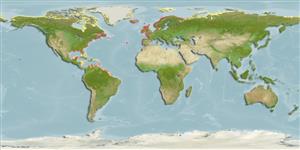Common names from other countries
Classification / Names / Names
ماع يماسا | فدارتم | Catalog of Fishes (gen., sp.) | ITIS | CoL | WoRMS
Environment: milieu / climate zone / depth range / distribution range
يسانش موب
; روش بل; قمع تارييغت 0 - 15 m (Ref. 97531). Tropical
Western Atlantic: USA and Canada. The Arctic. Tropical to polar climates of northern hemisphere.
Length at first maturity / Size / Weight / نس
Maturity: Lm ? range ? - ? cm
Often found near underwater structures and dense stands of aquatic macrophytes in shallow areas of estuaries. During the spawning season, the female molts and becomes receptive to the male. Copulation occurs within 7 hours after molting. Ova are externally fertilized on the ventral surface of the female abdomen. Fecundity is between 247 to 486 eggs per female. Eggs hatch 12 to 60 days after fertilization. After spawning, the female molts again. Larvae are planktonic and feed on zooplankton, algae, and detritus. Movement and distributional patterns likely influenced by both photoperiod and tidal cycles. Mainly detritivorous; also feeds on epiphytic microalgae and prey on meiofauna and small infaunal polychaetes, oligochaetes, nematodes, epiphytic fauna, and mysids. Preyed upon by various estuarine fishes and other aquatic carnivores. Host to numerous species of parasites and ectocommensals, primarily coccidia, microsporidians, trematodes, isopods, and leeches (Ref. 96311). Also on seagrasses and submerged vegetation (Ref. 97531).
Life cycle and mating behavior
غولب | لثم دیلوت | یزیر مخت | اه مخت | Fecundity | )ورال ( دازوت
Members of the order Decapoda are mostly gonochoric. Mating behavior: Precopulatory courtship ritual is common (through olfactory and tactile cues); usually indirect sperm transfer.
یلصا ذخآم
عجارم | هدننك گنهامه | ناراكمه
Williams, A.B., L.G. Abele, D.L. Felder, H.H. Hobbs Jr., R.B. Manning, P.A. McLaughlin and I. Pérez Farfante. 1988. (Ref. 2214)
NCUI زمرق تسرهف رد تيعضو (Ref. 130435)
ستياس رظن زا تيعضو (Ref. 108899)
Not Evaluated
Not Evaluated
یناسنا هدافتسا
| FishSource |
اهرازبا
رتشيب تاعالطا
Age/Size
دشر
نزو - لوط
لوط - لوط
يسانش تخير
)ورال ( دازوت
يناوارف
يتنرتنيا عبانم
Estimates based on models
